NVIDIA GeForce GTX 780 Review: The New High End
by Ryan Smith on May 23, 2013 9:00 AM ESTPower, Temperature, & Noise
As always, last but not least is our look at power, temperature, and noise. Next to price and performance of course, these are some of the most important aspects of a GPU, due in large part to the impact of noise. All things considered, a loud card is undesirable unless there’s a sufficiently good reason – or sufficiently good performance – to ignore the noise.
GTX 780 comes into this phase of our testing with a very distinct advantage. Being based on an already exceptionally solid card in the GTX Titan, it’s guaranteed to do at least as well as Titan here. At the same time because its practical power consumption is going to be a bit lower due to the fewer enabled SMXes and fewer RAM chips, it can be said that it has Titan’s cooler and a lower yet TDP, which can be a silent (but deadly) combination.
| GeForce GTX 780 Voltages | ||||
| GTX 780 Max Boost | GTX 780 Base | GTX 780 Idle | ||
| 1.1625v | 1.025v | 0.875v | ||
Unsurprisingly, voltages are unchanged from Titan. GK110’s max safe load voltage is 1.1625v, with 1.2v being the maximum overvoltage allowed by NVIDIA. Meanwhile idle remains at 0.875v, and as we’ll see idle power consumption is equal too.
Meanwhile we also took the liberty of capturing the average clockspeeds of the GTX 780 in all of the games in our benchmark suite. In short, although the GTX 780 has a higher base clock than Titan (863MHz versus 837MHz), the fact that it only goes to one higher boost bin (1006MHz versus 993MHz) means that the GTX 780 doesn’t usually clock much higher than GTX Titan under load; for one reason or another it typically settles at the boost bin as the GTX Titan on tests that offer consistent work loads. This means that in practice the GTX 780 is closer to a straight-up harvested GTX Titan, with no practical clockspeed differences.
| GeForce GTX Titan Average Clockspeeds | ||||
| GTX 780 | GTX Titan | |||
| Max Boost Clock | 1006MHz | 992MHz | ||
| DiRT:S |
1006MHz
|
992MHz | ||
| Shogun 2 |
966MHz
|
966MHz | ||
| Hitman |
992MHz
|
992MHz | ||
| Sleeping Dogs |
969MHz
|
966MHz | ||
| Crysis |
992MHz
|
992MHz | ||
| Far Cry 3 |
979MHz
|
979MHz | ||
| Battlefield 3 |
992MHz
|
992MHz | ||
| Civilization V |
1006MHz
|
979MHz | ||
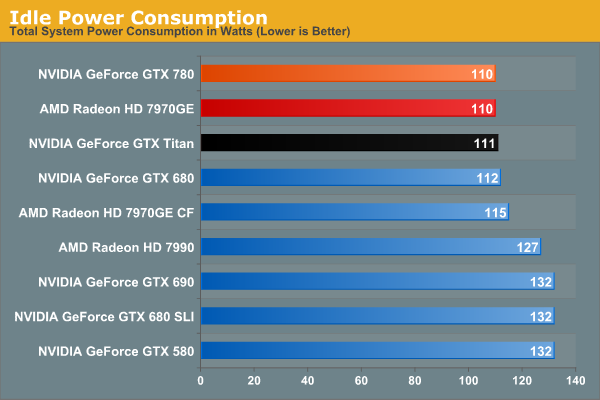
Idle power consumption is by the book. With the GTX 780 equipped, our test system sees 110W at the wall, a mere 1W difference from GTX Titan, and tied with the 7970GE. Idle power consumption of video cards is getting low enough that there’s not a great deal of difference between the latest generation cards, and what’s left is essentially lost as noise.
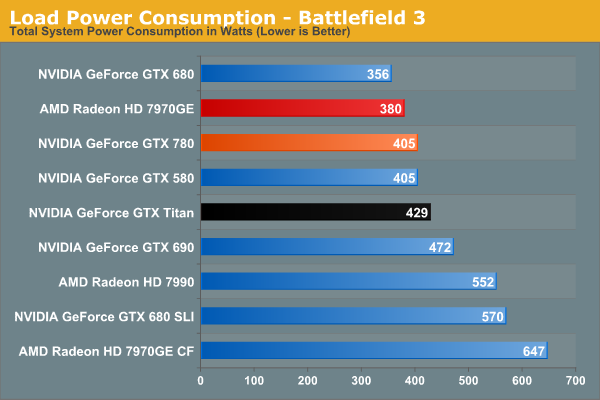
Moving on to power consumption under Battlefield 3, we get our first real confirmation of our earlier theories on power consumption. Between the slightly lower load placed on the CPU from the lower framerate, and the lower power consumption of the card itself, GTX 780 draws 24W less at the wall. Interestingly this is exactly how much our system draws with the GTX 580 too, which accounting for lower CPU power consumption means that video card power consumption on the GTX 780 is down compared to the GTX 580. GTX 780 being a harvested part helps a bit with that, but it still means we’re looking at quite the boost in performance relative to the GTX 580 for a simultaneous decrease in video card power consumption.
Moving along, we see that power consumption at the wall is higher than both the GTX 680 and 7970GE. The former is self-explanatory: the GTX 780 features a bigger GPU and more RAM, but is made on the same 28nm process as the GTX 680. So for a tangible performance improvement within the same generation, there’s nowhere for power consumption to go but up. Meanwhile as compared to the 7970GE, we are likely seeing a combination of CPU power consumption differences and at least some difference in video card power consumption, though this doesn’t make it possible to specify how much of each.
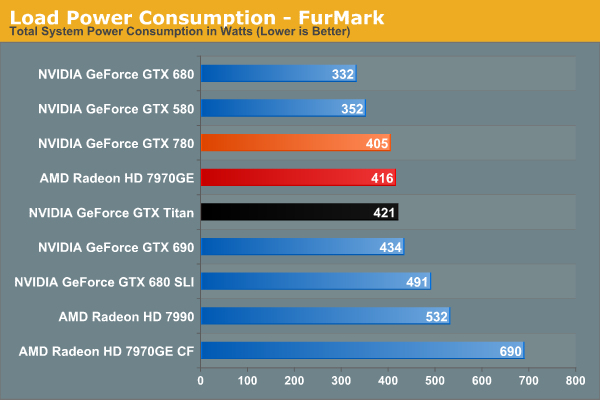
Switching to FurMark and its more pure GPU load, our results become compressed somewhat as the GTX 780 moves slightly ahead of the 7970GE. Power consumption relative to Titan is lower than what we expected it to be considering both cards are hitting their TDP limits, though compared to GTX 680 it’s roughly where it should be. At the same time this reflects a somewhat unexpected advantage for NVIDIA; despite the fact that GK110 is a bigger and logically more power hungry GPU than AMD’s Tahiti, the power consumption of the resulting cards isn’t all that different. Somehow NVIDIA has a slight efficiency advantage here.
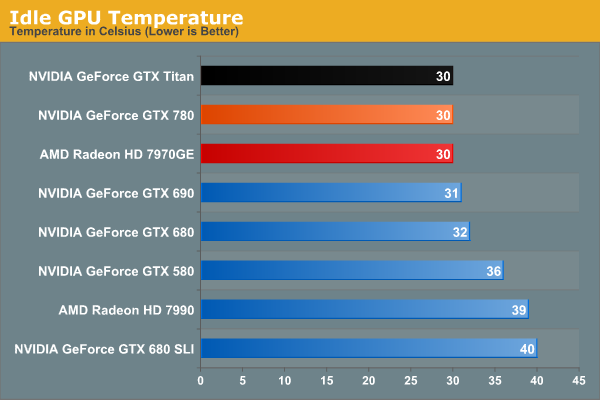
Moving on to idle temperatures, we see that GTX 780 hits the same 30C mark as GTX Titan and 7970GE.
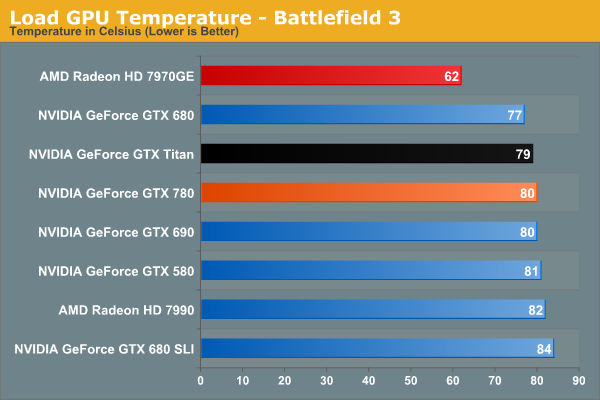
With GPU Boost 2.0, load temperatures are kept tightly in check when gaming. The GTX 780’s default throttle point is 80C, and that’s exactly what happens here, with GTX 780 bouncing around that number while shifting between its two highest boost bins. Note that like Titan however this means it’s quite a bit warmer than the open air cooled 7970GE, so it will be interesting to see if semi-custom GTX 780 cards change this picture at all.
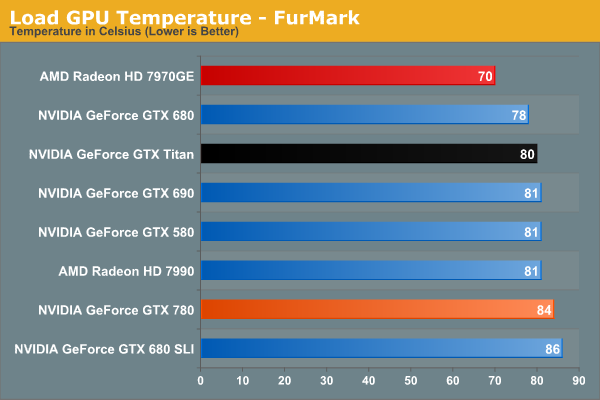
Whereas GPU Boost 2.0 keeps a lid on things when gaming, it’s apparently a bit more flexible on FurMark, likely because the video card is already heavily TDP throttled.
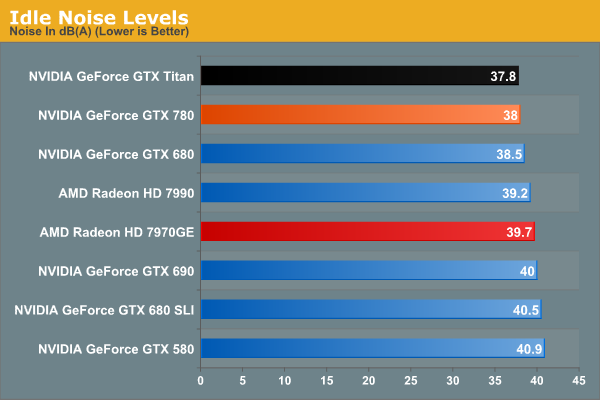
Last but not least we have our look at idle noise. At 38dB GTX 780 is essentially tied with GTX Titan, which again comes at no great surprise. At least in our testing environment one would be hard pressed to tell the difference between GTX 680, GTX 780, and GTX Titan at idle. They’re essentially as quiet as a card can get without being silent.
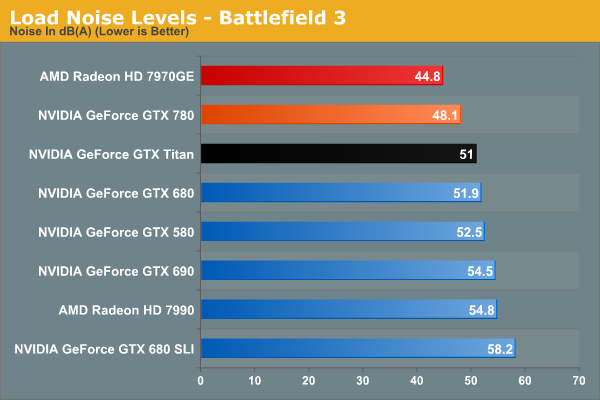
Under BF3 we see the payoff of NVIDIA’s fan modifications, along with the slightly lower effective TDP of GTX 780. Despite – or rather because – it was built on the same platform as GTX Titan, there’s nowhere for idle noise to go down. As a result we have a 250W blower based card hitting 48.1dB under load, which is simply unheard of. At nearly a 4dB improvement over both GTX 680 and GTX 690 it’s a small but significant improvement over NVIDIA’s previous generation cards, and even Titan has the right to be embarrassed. Silent it is not, but this is incredibly impressive for a blower. The only way to beat something like this is with an open air card, as evidenced by the 7970GE, though that does comes with the usual tradeoffs for using such a cooler.
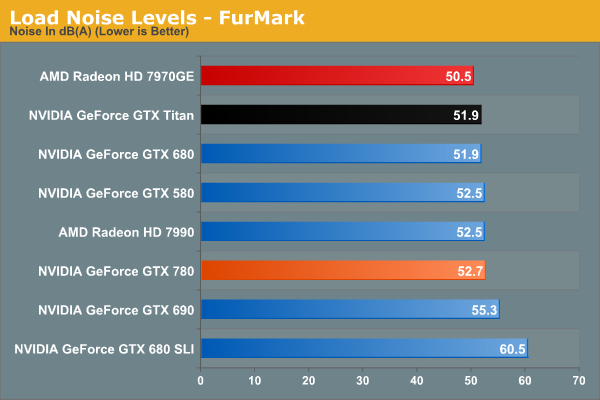
Because of the slightly elevated FurMark temperatures we saw previously, GTX 780 ends up being a bit louder than GTX Titan under FurMark. This isn’t something that we expect to see under any non-pathological workload, and I tend to favor BF3 over FurMark here anyhow, but it does point to there being some kind of minor difference in throttling mechanisms between the two cards. At the same time this means that GTX 780 is still a bit louder than our open air cooled 7970GE, though not by as large a difference as we saw with BF3.
Overall the GTX 780 generally meets or exceeds the GTX Titan in our power, temp, and noise tests, just as we’d expect for a card almost identical to Titan itself. The end result is that it maintains every bit of Titan’s luxury and stellar performance, and if anything improves on it slightly when we’re talking about the all-important aspects of load noise. It’s a shame that coolers such as 780’s are not a common fixture on cheaper cards, as this is essentially unparalleled as far as blower based coolers are concerned.
At the same time this sets up an interesting challenge for NVIDIA’s partners. To pass Greenlight they need to produce cards with coolers that function as good or as better than the reference GTX 780 in NVIDIA’s test environment. This is by no means impossible, but it’s not going to be an easy task. So it will be interesting to see what partners cook up, especially with the obligatory dual fan open air cooled models.










155 Comments
View All Comments
milkman001 - Friday, May 24, 2013 - link
FYI,On the "Total War: Shogun 2" page, you have the 2650x1440 graph posted twice.
JDG1980 - Saturday, May 25, 2013 - link
I don't think that the release of this card itself is problematic for Titan owners - everyone knows that GPU vendors start at the top and work their way down with new silicon, so this shouldn't have come as much of a surprise.What I do find problematic is their refusal to push out BIOS-based fan controller improvements to Titan owners. *That* comes off as a slap in the face. Someone spends $1000 on a new video card, they deserve top-notch service and updates.
inighthawki - Saturday, May 25, 2013 - link
The typically swapchain format is something like R8G8B8A8 and the alpha channel is typically ignored (value of 0xFF typically written), since it is of no use to the OS, since it will not alpha blend with the rest of the GUI. You can create a 24-bit format, but it's very likely that for performance reasons, the driver will allocate it as if it were a 32-bit format, and not write to the upper 8 bits. The hardware is often only capable of writing to 32 bit aligned places, so its more beneficial for the hardware to just waste 8 bits of data and not have to do any fancy shifting to read or write from each pixel. I've actually seen cases where some drivers will allocate 8-bit formats as 32-bit formats, wasting 4x the space the user thought they were allocating.jeremyshaw - Saturday, May 25, 2013 - link
As a current GTX580 owner running at 2560x1440, I don't have any want of upgrade, especially in compute performance. I think I'll hold out for at least one more generation, before deciding.ahamling27 - Saturday, May 25, 2013 - link
As a GTX 560 Ti owner, I am chomping at the bit to pick up an upgrade. The Titan was out of the question, but the 780 looks a lot better at 65% of the cost for 90% of the performance. The only thing holding me back is that I'm still on z67 with a 2600k overclocked to 4.5 ghz. I don't see a need to rebuild my entire system as it's almost on par with the z77/3770. The problem is that I'm still on PCIe 2.0 and I'm worried that it would bottleneck a 780.Considering a 780 is aimed at us with 5xx or lower cards, it doesn't make sense if we have to abandon our platform just to upgrade our graphics card. So could you maybe test a 780 on PCIe 2.0 vs 3.0 and let us know if it's going to bottleneck on 2.0?
Ogdin - Sunday, May 26, 2013 - link
There will be no bottleneck.mapesdhs - Sunday, May 26, 2013 - link
Ogdin is right, it shouldn't be a bottleneck. And with a decent air cooler, you ought to be
able to get your 2600K to 5.0, so you have some headroom there aswell.
Lastly, you say you have a GTX 560 Ti. Are you aware that adding a 2nd card will give
performance akin to a GTX 670? And two 560 Tis oc'd is better than a stock 680 (VRAM
capacity not withstanding, ie. I'm assuming you have a 1GB card). Here's my 560Ti SLI
at stock:
http://www.3dmark.com/3dm11/6035982
and oc'd:
http://www.3dmark.com/3dm11/6037434
So, if you don't want the expense of an all new card for a while at the cost level of a 780,
but do want some extra performance in the meantime, then just get a 2nd 560Ti (good
prices on eBay these days), it will run very nicely indeed. My two Tis were only 177 UKP
total - less than half the cost of a 680, though atm I just run them at stock speed, don't
need the extra from an oc. The only caveat is VRAM, but that shouldn't be too much of
an issue unless you're running at 2560x1440, etc.
Ian.
ahamling27 - Wednesday, May 29, 2013 - link
Thanks for the reply! I thought about SLI but ultimately the 1 GB of vram is really going to hurt going forward. I'm not going to grab a 780 right away, because I want to see what custom models come out in the next few weeks. Although, EVGA's ACX cooler looks nice, I just want to see some performance numbers before I bite the bullet.Thanks again!
inighthawki - Tuesday, May 28, 2013 - link
Your comment is inaccurate. Just because a game requires "only 512MB" of video ram doesn't mean that's all it'll use. Video memory can be streamed in on the fly as needed off the hard drive, and as a result you can easily use a lot if you wanted as a performance optimization. I would not be the least bit surprised to see games on next gen consoles using WAY more video memory than regular memory. Running a game that "requires" 512MB of VRAM on a GPU with 4GB of VRAM gives it 3.5GB more storage to cache higher resolution textures.AmericanZ28 - Tuesday, May 28, 2013 - link
NVIDIA=FAIL....AGAIN! 780 Performs on par with a 7970GE, yet the GE costs $100 LESS than the 680, and $250 LESS than the 780.